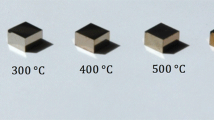Abstract
Aluminum alloy 6061 is commonly used as fuel cladding in nuclear research and test reactors. Over time, this cladding will oxidize and reduce heat transfer from the fuel to the reactor pool, which is a safety concern. Previous oxide growth predictions for these reactors are based on correlations developed from data taken at higher temperatures and pressures and may be overly conservative. This work assesses the validity of three existing oxide growth rate correlations at lower temperatures and pressures by measuring the oxide thickness formed over six months of exposure to water. In addition, we compare the corrosion rate of the as-received samples to the prefilmed samples that have a thin boehmite layer in order to assess the benefit of this surface modification. Samples were analyzed by scanning electron microscopy, energy dispersive spectroscopy, and X-ray diffraction to characterize the oxide thickness, chemistry, and crystal structure, respectively. Open-circuit potential monitoring, electrochemical impedance spectroscopy, linear polarization resistance, and cyclic voltammetry were used to study corrosion resistance. Results show that the boehmite on the prefilmed samples is a stable, protective phase under the conditions tested. The non-prefilmed samples produced a partially crystalline unprotective oxide, with a linear rate of oxide growth. The prefilming process is deemed necessary for fuel cladding applications, and two of the three correlations considered herein conservatively predicted the oxide thickness of the prefilmed samples.













Similar content being viewed by others
References
E. Shaber and G. Hofman: Report No. INL/EXT-05-00256, Idaho National Laboratory Idaho Falls, ID, 2005.
J.C. Griess, H.C. Savage, T.H. Mauney, and J.L. English: Report No. ORNL-2939, Oak Ridge National Laboratory, Oak Ridge, TN, 1960.
J.C. Griess, H.C. Savage, T.H. Mauney, J.L. English, and J.G. Rainwater: Report No. ORNL-3056, Oak Ridge National Laboratory, Oak Ridge, TN, 1961.
J.C. Griess, H.C. Savage, J.G. Rainwater, T.H. Mauney, and J.L. English: Report No. ORNL-3230, Oak Ridge National Laboratory, Oak Ridge, TN, 1961.
J.C. Griess, H.C. Savage, and J.L. English: Report No. ORNL-3541, Oak Ridge National Laboratory, 1964.
R.E. Pawel, G.L. Yoder, C.D. West, and B.H. Montgomery: Report No. ORNL/TM-11517, Oak Ridge National Laboratory, Oak Ridge, TN, 1990.
S.J. Pawel, D.K. Felde, and R.E. Pawel: Report No. ORNL/TM-13083, Oak Ridge National Laboratory, Oak Ridge, TN, 1995.
R.E. Pawel: Report No. ORNL/TM-10602, Oak Ridge National Laboratory, Oak Ridge, 1988.
G.H. Hanson, W.J. Bush, M.L. Briebenow, G.N. Fillmore, and H.H. Nielsen: in American Nuclear Society Annual Meeting, American Nuclear Society, Philadelphia, PA, 1974, pp. 127–28.
S.E. Aleman: Report No. DPST-84-903, Savannah River Laboratory, 1984.
R.S. Ondrojcin: Report No. DPST-83-324, Savannah River Laboratory, 1983.
Y.S. Kim, G.L. Hofman, N.A. Hanan, and J.L. Snelgrove: in International Meeting on Reduced Enrichment for Research and Test Reactors, Chicago, IL, USA, 2003, pp. 1–11.
Y.S. Kim, G.L. Hofman, A.B. Robinson, J.L. Snelgrove and N. Hanan, Journal of Nuclear Materials 2008, vol. 378, pp. 220-228.
W.R. Marcum, D.M. Wachs, A.B. Robinson and M.A. Lillo, Journal of Nuclear Materials 2016, vol. 471, pp. 136-148.
D.A. Jones: Principles and Prevention of Corrosion. Macmillan, 1992.
Acknowledgments
The authors would like to extend their gratitude to BWX Technologies Inc. for providing the sample material for the boehmite prefilmed coupons and the Idaho National Laboratory for the sample material without boehmite. Furthermore, the support of those who provided feedback during the development of this work-scope is much appreciated.
Author information
Authors and Affiliations
Corresponding authors
Additional information
Publisher's Note
Springer Nature remains neutral with regard to jurisdictional claims in published maps and institutional affiliations.
Manuscript submitted July 11, 2016.
Rights and permissions
About this article
Cite this article
Tucker, J.D., Wei, Y., Marcum, W.R. et al. Quantifying Oxide Layer Growth at Low Pressures and Temperatures for Aluminum Alloy 6061. Metall Mater Trans A 50, 3388–3398 (2019). https://doi.org/10.1007/s11661-019-05256-3
Received:
Published:
Issue Date:
DOI: https://doi.org/10.1007/s11661-019-05256-3



